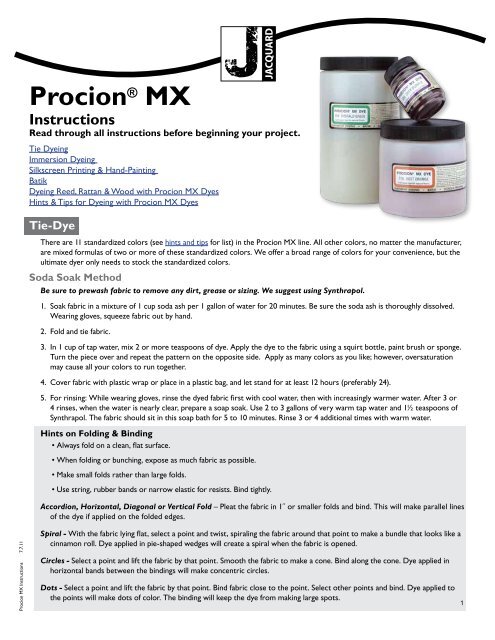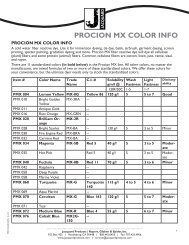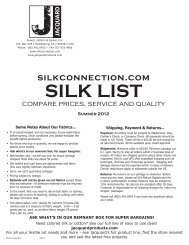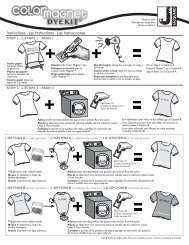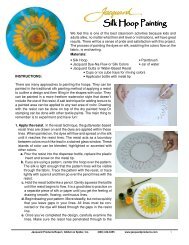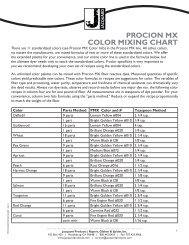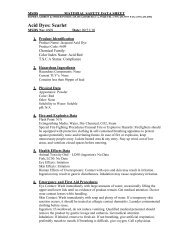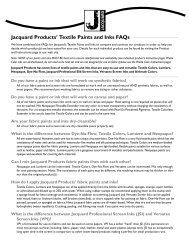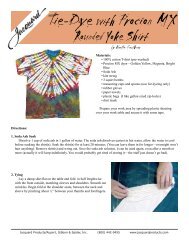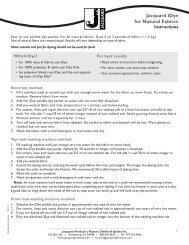Procion MX Instructions - Jacquard Products
Procion MX Instructions - Jacquard Products
Procion MX Instructions - Jacquard Products
Create successful ePaper yourself
Turn your PDF publications into a flip-book with our unique Google optimized e-Paper software.
<strong>Procion</strong> <strong>MX</strong> <strong>Instructions</strong> 7.7.11<br />
<strong>Procion</strong> ® <strong>MX</strong><br />
<strong>Instructions</strong><br />
Read through all instructions before beginning your project.<br />
Tie Dyeing<br />
Immersion Dyeing<br />
Silkscreen Printing & Hand-Painting<br />
Batik<br />
Dyeing Reed, Rattan & Wood with <strong>Procion</strong> <strong>MX</strong> Dyes<br />
Hints & Tips for Dyeing with <strong>Procion</strong> <strong>MX</strong> Dyes<br />
Tie-Dye<br />
There are 11 standardized colors (see hints and tips for list) in the <strong>Procion</strong> <strong>MX</strong> line. All other colors, no matter the manufacturer,<br />
are mixed formulas of two or more of these standardized colors. We offer a broad range of colors for your convenience, but the<br />
ultimate dyer only needs to stock the standardized colors.<br />
Soda Soak Method<br />
Be sure to prewash fabric to remove any dirt, grease or sizing. We suggest using Synthrapol.<br />
1. Soak fabric in a mixture of 1 cup soda ash per 1 gallon of water for 20 minutes. Be sure the soda ash is thoroughly dissolved.<br />
Wearing gloves, squeeze fabric out by hand.<br />
2. Fold and tie fabric.<br />
3. In 1 cup of tap water, mix 2 or more teaspoons of dye. Apply the dye to the fabric using a squirt bottle, paint brush or sponge.<br />
Turn the piece over and repeat the pattern on the opposite side. Apply as many colors as you like; however, oversaturation<br />
may cause all your colors to run together.<br />
4. Cover fabric with plastic wrap or place in a plastic bag, and let stand for at least 12 hours (preferably 24).<br />
5. For rinsing: While wearing gloves, rinse the dyed fabric first with cool water, then with increasingly warmer water. After 3 or<br />
4 rinses, when the water is nearly clear, prepare a soap soak. Use 2 to 3 gallons of very warm tap water and 1½ teaspoons of<br />
Synthrapol. The fabric should sit in this soap bath for 5 to 10 minutes. Rinse 3 or 4 additional times with warm water.<br />
Hints on Folding & Binding<br />
• Always fold on a clean, flat surface.<br />
• When folding or bunching, expose as much fabric as possible.<br />
• Make small folds rather than large folds.<br />
• Use string, rubber bands or narrow elastic for resists. Bind tightly.<br />
Accordion, Horizontal, Diagonal or Vertical Fold – Pleat the fabric in 1˝ or smaller folds and bind. This will make parallel lines<br />
of the dye if applied on the folded edges.<br />
Spiral - With the fabric lying flat, select a point and twist, spiraling the fabric around that point to make a bundle that looks like a<br />
cinnamon roll. Dye applied in pie-shaped wedges will create a spiral when the fabric is opened.<br />
Circles - Select a point and lift the fabric by that point. Smooth the fabric to make a cone. Bind along the cone. Dye applied in<br />
horizontal bands between the bindings will make concentric circles.<br />
Dots - Select a point and lift the fabric by that point. Bind fabric close to the point. Select other points and bind. Dye applied to<br />
the points will make dots of color. The binding will keep the dye from making large spots.<br />
1
<strong>Procion</strong> <strong>MX</strong> <strong>Instructions</strong> 7.7.11<br />
Remember that these techniques discussed here are only suggestions and a quick reference. There are a number of variations and<br />
possibilities when using dyes. You will find further examples at http://www.jacquardproducts.com/projects. Experimentation is the<br />
best method.<br />
Immersion Dyeing<br />
<strong>Jacquard</strong> <strong>Products</strong> | Rupert, Gibbon & Spider, Inc.<br />
P.O. Box 425, Healdsburg, CA 95448 | 800.442.0455 | Fax: 707.433.4906<br />
www.jacquardproducts.com | service@jacquardproducts.com<br />
Back to top<br />
There are 11 standardized colors (see hints and tips for list) in the <strong>Procion</strong> <strong>MX</strong> line. All other colors, no matter the manufacturer,<br />
are mixed formulas of two or more of these standardized colors. We offer a broad range of colors for your convenience, but the<br />
ultimate dyer only needs to stock the standardized colors.<br />
Immersion or tub dyeing is submerging the fiber being dyed in the dye bath containing water, a specific amount of dye and the<br />
appropriate chemical assistants for a specific length of time. For smooth, even color, the dye bath must be stirred frequently. A<br />
large enamel or stainless steel container or plastic bucket can be used for holding the dye bath.<br />
Stirring Fiber Reactive Dye Baths<br />
For even, smooth color, the fiber should be able to move freely in the dye bath. Additional water in the dye bath will dilute the<br />
dyes more than necessary and decrease the shade and increase the dyeing time. Increasing the volume of the dye bath requires<br />
the dye time to be longer for the dye molecules to reach the fiber. To prevent uneven dyeing stir dye bath frequently (every 2 to<br />
5 minutes). To stir fabric, wear rubber gloves and lift the fiber from the dye bath. Unfold the creases, and return the fiber to the<br />
bath in a different configuration. To stir yarn, use two stainless steel, Plexiglas or wooden stir sticks. Gently slide one stick into<br />
the skein near a cross-tie and lift above the dye bath. With the other stick, pick up a different point of the cross-tie on the skein.<br />
Remove the first stick and use that stick to redirect the yarn back into the dye pot in a different pattern.<br />
General amounts of dye, salt and soda ash per 3 gallons of water and one pound of fabric:<br />
For very pale shades: ¼ to ½ teaspoon dye, 1½ cups salt, ¼ cup soda ash<br />
For light shades: ½ to 1 teaspoon dye, 1½ cups salt, ¼ cup soda ash<br />
For medium shades: 1 tablespoon dye, 1½ cups salt, ¼ cup soda ash<br />
For darker shades: 2 tablespoons dye, 2 cups salt, ¼ cup soda ash<br />
For darkest shades: 4 tablespoons dye, 3 cups salt, ¹/ ³ cup soda ash<br />
Immersion Dyeing Cellulose Fibers<br />
For one pound dry weight of fabric or fiber (3 to 6 square yards of fabric or 3 T-shirts)<br />
Materials:<br />
• 3 gallons of warm water (105° F)<br />
• <strong>Procion</strong>® <strong>MX</strong> dye (see above in for amounts)<br />
• ¼ to ¹/ ³ cup of soda ash<br />
• 1½ to 3 cups of salt (non-iodized)<br />
• Synthrapol for prewashing and post-rinsing<br />
Two methods of dyeing follow:<br />
Be sure to prewash fabric to remove any dirt, grease or sizing. We suggest using Synthrapol.<br />
Method One:<br />
1. Fill container (such as a 5 gallon plastic bucket) with 3 gallons of warm (105° F) tap water. Add salt and dye in proportions listed<br />
in the general dye amounts above.<br />
2. Add the fabric or fiber.<br />
3. Stir frequently for 10 to 15 minutes.<br />
4. Remove or lift up the fabric.<br />
2
<strong>Procion</strong> <strong>MX</strong> <strong>Instructions</strong> 7.7.11<br />
5. Add the soda ash. (It helps to dissolve the soda ash in a separate container in a little hot water first.) Stir into dye bath.<br />
6. Put the fabric back into dye bath and stir frequently for 30 to 60 minutes, (depending on the depth of intensity desired).<br />
Rinsing:<br />
• While wearing gloves, rinse the dyed fiber first with cool water, then with increasingly warmer water.<br />
• After 3 or 4 rinses, when the water is nearly clear, prepare a soap soak. Use 2 to 3 gallons of very warm tap water and<br />
1½ teaspoons of Synthrapol. The fiber should sit in this soap bath for 5 to 10 minutes.<br />
• Rinse 3 or 4 additional times with warm water.<br />
• Using either <strong>Jacquard</strong>’s Dyeset Concentrate or <strong>Jacquard</strong>’s iDye Fixative during the initial rinse will further ensure long<br />
lasting colors.<br />
Method Two:<br />
1. Fill container with 3 gallons of warm (105° F) tap water, add dye and stir.<br />
2. Add the fabric or fiber.<br />
3. Add the salt in 3 equal parts at 5 minute intervals. If dyeing a deep shade of blue or a full black, use twice the amount of salt,<br />
(adding it in 2 equal parts at 15 minute intervals) while still stirring the dye bath frequently.<br />
4. Add the soda ash in 2 equal parts at 15 minute intervals, while still stirring the dye bath frequently. (It helps to dissolve the soda<br />
ash in a separate container in a little hot water first.)<br />
5. Dye for 30 to 60 minutes after the last soda addition.<br />
Rinsing:<br />
• While wearing gloves, rinse the dyed fiber first with cool water, then with increasingly warmer water.<br />
• After 3 or 4 rinses, when the water is nearly clear, prepare a soap soak. Use 2 to 3 gallons of very warm tap water and<br />
1½ teaspoons of Synthrapol. The fiber should sit in this soap bath for 5 to 10 minutes.<br />
• Rinse 3 or 4 additional times with warm water.<br />
• Using either <strong>Jacquard</strong>’s Dyeset Concentrate or <strong>Jacquard</strong>’s iDye Fixative during the initial rinse will further ensure long<br />
lasting colors.<br />
Washing Machine Dyeing for Cellulose Fibers<br />
For 3 to 5 pounds of fabric (5 to 7 yards of fabric or 8 to 10 T-shirts)<br />
Be sure to prewash fabric to remove any dirt, grease or sizing. We suggest using Synthrapol.<br />
Materials:<br />
• Standard top-loading or front loading washing machine<br />
Steps<br />
• <strong>Procion</strong>® <strong>MX</strong> dye (double the amounts for Immersion dyeing listed in the immersion directions)<br />
• 2 cups soda ash (3 cups for darker shades)<br />
• 6 to 8 cups salt (non-iodized)<br />
• for prewashing and post-rinsing<br />
For top-loading machine:<br />
1. Set washing machine to smallest load appropriate to amount of fabric. Use hottest water setting.<br />
2. In separate containers pre-dissolve the salt in approximately ½ gallon of hot water and the dye in approximately ½ cup to<br />
1 cup of hot water.<br />
<strong>Jacquard</strong> <strong>Products</strong> | Rupert, Gibbon & Spider, Inc.<br />
P.O. Box 425, Healdsburg, CA 95448 | 800.442.0455 | Fax: 707.433.4906<br />
www.jacquardproducts.com | service@jacquardproducts.com<br />
3
<strong>Procion</strong> <strong>MX</strong> <strong>Instructions</strong> 7.7.11<br />
3. Place wet fabric in machine and agitate for 20 minutes. (The wash cycle needs to be extended, without the dye being drained or<br />
more water added, by turning the machine off and resetting at beginning of wash cycle.)<br />
4. In a separate container pre-dissolve soda ash in approximately ½ gallon of hot water.<br />
5. Gradually add to dye bath in 3 parts at 5 minute intervals, being careful not to pour directly onto fabric.<br />
6. Agitate for 50 minutes (30 minutes for pastels).<br />
7. Let machine drain the dye bath and complete the rinse cycle. To remove any remaining dye, run through a complete wash cycle<br />
with hot water and Synthrapol.<br />
For front-loading machine:<br />
1. Set washing machine to smallest load appropriate to amount of fabric. Use hottest water setting.<br />
2. In separate containers pre-dissolve: the salt in approximately ½ gallon of hot water, the dye in approximately ½ cup to 1 cup of<br />
hot water and the soda ash in approximately ½ gallon of hot water.<br />
3. Pour salt, dye and soda ash into the washing machine.<br />
4. Place wet fabric in the machine and (choosing the longest cycle available) start the machine. If your machine allows, extend the<br />
wash cycle before the dye bath drains.<br />
5. Agitate for as long as your machine allows, up to 50 minutes (30 minutes for pastels).<br />
6. Let machine drain the dye bath and complete the rinse cycle. To remove any remaining dye, run through a complete wash cycle<br />
with hot water and Synthrapol.<br />
Note: After dyeing in your washing machine we recommend cleaning the machine per the manufacturers recommended<br />
method and then running a short cycle of clear water before the next use. This is especially important with front-loading<br />
machines, because they will often hold liquids in the seal around the door or in the exterior tub of the washer.<br />
Immersion Dyeing for Protein Fibers<br />
Wool yarn, fabric, fleece and all animal hair fibers are dyed with this method. Silk, yarn and fabric are dyed using the protein<br />
method, but the dye bath is run at 100°F rather than heated. Please keep in mind that dye colors can shift (change) when using with<br />
protein fibers.<br />
For one pound dry weight of fabric or fiber (3 to 6 square yards of fabric or 3 T-shirts)<br />
Be sure to prewash fiber to remove any dirt, grease or sizing. We suggest using Synthrapol.<br />
Materials:<br />
• 3 gallons of warm water (105° F) (use cool water for wool)<br />
• <strong>Procion</strong>® <strong>MX</strong> dye (see above for general amounts)<br />
• 1½ to 3 cups of salt (non-iodized)<br />
Steps:<br />
1. In a stainless steel or enamel pot, add water, dye and salt. Stir to dissolve.<br />
2. Place pot on stove and stir.<br />
3. Add pre-wetted fiber.<br />
4. Raise the temperature over a 15 minute time span to simmer, stirring frequently. If you are dyeing wool, a gradual heating and<br />
gradual cooling of the dye bath is important so as not to shock and felt the wool.<br />
5. Remove or lift out the fiber, add the vinegar and stir.<br />
6. Return the fiber to the dye bath. Stir frequently at a simmer (about 180° to 195° F) for 30 to 45 minutes.<br />
7. Allow to cool before rinsing.<br />
• ¼ cup 5% acetic acid (white vinegar) per pound<br />
of fiber<br />
• Synthrapol for prewashing and post-rinsing<br />
<strong>Jacquard</strong> <strong>Products</strong> | Rupert, Gibbon & Spider, Inc.<br />
P.O. Box 425, Healdsburg, CA 95448 | 800.442.0455 | Fax: 707.433.4906<br />
www.jacquardproducts.com | service@jacquardproducts.com<br />
4
<strong>Procion</strong> <strong>MX</strong> <strong>Instructions</strong> 7.7.11<br />
Rinsing:<br />
For wool or other fibers that may felt, use only cool water in each rinse as well as the soap soak. Gentle handling during rinsing is<br />
also important to reduce the possibility of felting.<br />
• While wearing gloves, gently rinse the dyed fiber with cool water.<br />
• After 3 or 4 rinses, when the water is nearly clear, prepare a soap soak. Use 2 to 3 gallons of cool tap water and 1½ teaspoons<br />
of Synthrapol. The fiber should sit in this soap bath for 5 to 10 minutes.<br />
• Rinse 3 or 4 additional times with cool water.<br />
• Using of either <strong>Jacquard</strong>’s Dyeset Concentrate or <strong>Jacquard</strong>’s iDye Fixative during the initial rinse will further ensure long<br />
lasting colors.<br />
Washing Machine Dyeing for Protein Fibers<br />
Be sure to prewash fiber to remove any dirt, grease or sizing. We suggest using Synthrapol.<br />
For 3 to 5 pounds of fabric (5 to 7 yards of fabric) NOT RECOMMENDED FOR WOOL YARN, FABRIC, FLEECE OR OTHER<br />
ANIMAL HAIR FIBERS.<br />
Materials:<br />
• Standard top-loading washing machine<br />
• <strong>Procion</strong>® <strong>MX</strong> dye (double the amounts for Immersion dyeing listed in the Immersion directions)<br />
• 1 to 3 cups of 5% acetic acid (white vinegar) depending on the volume of water<br />
• 6 to 8 cups salt (non-iodized)<br />
For top-loading machine:<br />
1. Set washing machine to smallest load appropriate to amount of fabric. Use hot water setting.<br />
2. In separate containers pre-dissolve: the salt in approximately ½ gallon of water of hot water and the dye in approximately<br />
½ cup to 1 cup of hot water.<br />
3. Place wet fabric in machine and agitate for 20 minutes. (The wash cycle needs to be extended, without the dye being drained or<br />
more water added, by turning the machine off and resetting at beginning of wash cycle.)<br />
4. Gradually add vinegar to dye bath, being careful not to pour directly onto fabric.<br />
5. Agitate for 50 minutes (30 minutes for pastels).<br />
6. Let machine drain the dye bath and complete the rinse cycle. To remove any remaining dye, run through a complete wash cycle<br />
with cool water and Synthrapol.<br />
For front-loading machine:<br />
1. Set washing machine to smallest load appropriate to amount of fabric. Use hot water setting.<br />
2. In separate containers pre-dissolve: the salt in approximately ½ gallon of water of hot water and the dye in approximately<br />
½ cup to 1 cup of hot water.<br />
3. Pour salt, dye and vinegar into the washing machine.<br />
4. Place wet fabric in the machine and (choosing the longest cycle available) start the machine. If your machine allows, extend the<br />
wash cycle before the dye bath drains.<br />
5. Agitate for as long as your machine allows up to 50 minutes (30 minutes for pastels).<br />
6. Let machine drain the dye bath and complete the rinse cycle. To remove any remaining dye, run through a complete wash cycle<br />
with cool water and Synthrapol.<br />
Note: After dyeing in your washing machine we recommend cleaning the machine using the manufacturer’s recommended<br />
method and then running a short cycle of clear water before the next use. This is especially important with front-loading<br />
machines because they will often hold liquids in the seal around the door or in the exterior tub of the washer. Back to top<br />
<strong>Jacquard</strong> <strong>Products</strong> | Rupert, Gibbon & Spider, Inc.<br />
P.O. Box 425, Healdsburg, CA 95448 | 800.442.0455 | Fax: 707.433.4906<br />
www.jacquardproducts.com | service@jacquardproducts.com<br />
5
<strong>Procion</strong> <strong>MX</strong> <strong>Instructions</strong> 7.7.11<br />
Silkscreen Printing & Hand-Painting<br />
There are 11 standardized colors (see hints and tips for list) in the <strong>Procion</strong> <strong>MX</strong> line. All other colors, no matter the manufacturer,<br />
are mixed formulas of two or more of these standardized colors. We offer a broad range of colors for your convenience, but the<br />
ultimate dyer only needs to stock the standardized colors.<br />
Directions for Cellulous Fabrics<br />
Preparing Dye Thickener<br />
When screen printing with dye thickened with sodium alginate, the print base should be as thin as the image will allow. Dye<br />
printed in too thick a base will halo from the image before the fabric is cured or will accumulate in the corners, altering the image.<br />
SH is a high viscosity, low solids type of alginate thickener used primarily for cotton and other cellulose fibers. It may also be used<br />
for silk when fine line definition is not required.<br />
Materials:<br />
• Wide mouth quart jar<br />
• Measuring spoons<br />
• 4 teaspoons sodium alginate<br />
Mix at least 2 hours before actual use.<br />
Steps:<br />
1. Mix the Calgon and urea together in the jar.<br />
2. Add the hot water.<br />
3. Slowly add the sodium alginate, stirring constantly. Stir until dissolved.<br />
4. Add cool water until the mixture is no longer stiff but is not runny. This should make about 1 quart.<br />
5. Cover, label and store in the refrigerator.<br />
Standard Method<br />
Be sure to prewash fiber to remove any dirt, grease or sizing. We suggest using Synthrapol.<br />
The traditional method of printing or painting with fiber reactive dye is to add baking soda (sodium bicarbonate) to a<br />
thickener paste. This method can be used for screen printing, hand-painting, warp-painting, airbrush, stamping and all other<br />
direct application techniques. It is important to prepare the fiber by washing to remove the sizing.<br />
Steps:<br />
1. Iron clean, dry fabric.<br />
2. Prepare dye thickener paste per instructions above. Add ½ teaspoon baking soda to ½ cup thickener paste. The baking<br />
soda activates the dye reaction. Activated paste will remain usable for only 4 hours and then must be replaced with freshly<br />
activated paste.<br />
3. Divide the activated paste into several containers. Add ½ to 2 teaspoons of dye per ½ cup thickener. Proportion the dye in<br />
each container in relation to the amount of thickener paste and desired intensity.<br />
4. Print, paint, stamp or brush on fabric.<br />
5. Air dry completely.<br />
• 10 tablespoons urea<br />
• 1 teaspoon Calgon<br />
• 1½ cups hot water<br />
6. Steam set in a steam chamber or professional fabric steamer. See “Steam Method” in the Setting Screen Printed and Hand<br />
Painted Fabrics section below for more information.<br />
<strong>Jacquard</strong> <strong>Products</strong> | Rupert, Gibbon & Spider, Inc.<br />
P.O. Box 425, Healdsburg, CA 95448 | 800.442.0455 | Fax: 707.433.4906<br />
www.jacquardproducts.com | service@jacquardproducts.com<br />
6
<strong>Procion</strong> <strong>MX</strong> <strong>Instructions</strong> 7.7.11<br />
Presoak Method<br />
Be sure to prewash fiber to remove any dirt, grease or sizing. We suggest using Synthrapol.<br />
Fiber soaked in its chemical assistants (soda ash for cellulous fibers/vinegar or citric acid for protein fibers) readily accepts the<br />
<strong>Procion</strong> <strong>MX</strong> dye. When printed or painted on fibers, the dye bonds with the fiber as in immersion dyeing. After the dye reaction<br />
is complete and the printing medium is removed (by washing), the fiber retains its resilience and hand.<br />
The quantity of dye added to the printing paste will determine the intensity of the printed or painted color. ½ teaspoon to 2<br />
teaspoons of powdered dye to ½ cup thickener is the standard range, with 1 teaspoon being the medium to dark shade. Handpainting<br />
paste is made by thinning printing paste with a urea water solution (½ cup + 2 T Calgon to 1 quart water).<br />
Steps:<br />
1. For one pound of fiber, presoak in a solution of 1 gallon of water and 1 cup soda ash for 15 to 30 minutes. Do not rinse.<br />
Squeeze out excess solution, air dry and iron OR leave wet.<br />
2. Print or paint with the thickened dye solution. We recommend experimentating to find the quantity of dye for the color<br />
brilliance necessary. The dye will be transparent: that is, the color of the underneath fabric will blend with the dye. Red<br />
fabric printed with green will be brown. Unbleached muslin will tone down the dye colors.<br />
3. Set by batch method or by steaming. See Setting Screen Printed and Hand Painted Fabrics below for more information.<br />
Setting Screen Printed and Hand Painted Fabrics<br />
Batch Method<br />
The <strong>Procion</strong> <strong>MX</strong> fiber reactive dye will react with the fiber only while it is damp.<br />
1. While the fabric is still wet, place printed or painted fabric between two large sheets of plastic. Lay more damp fabric on top,<br />
making certain that the moisture will not directly contact the printed fabric.<br />
2. Loosely roll the fabric and plastic into a large bundle.<br />
3. Place bundle inside a large trash bag. Close the bag with an air pocket inside. Allow to sit for 8 to 48 hours for the dye to react.<br />
4. Rinsing: For wool or other fibers that may felt, use only cool water in each rinse and the soap soak. Gentle handling during rinsing<br />
is also important to reduce the possibility of felting.<br />
• While wearing gloves, rinse the dyed fiber first with cool water, then with increasingly warmer water.<br />
• After 3 or 4 rinses, when the water is nearly clear, prepare a soap soak. Use 2 to 3 gallons of very warm tap water and 1½<br />
teaspoons of Synthrapol. The fiber should sit in this soap bath for 5 to 10 minutes.<br />
• Rinse 3 or 4 additional times with warm water.<br />
• Using of either <strong>Jacquard</strong>’s Dyeset Concentrate or <strong>Jacquard</strong>’s iDye Fixative during the initial rinse will further ensure long<br />
lasting colors.<br />
Steam Method<br />
You can steam your fabric in a professional fabric steamer, or you can make your own steamer out of the materials listed below.<br />
Keep in mind that the quantity of fabric may dictate which type of method and steamer to use.<br />
See http://jacquardproducts.com/_downloads/instructions/Home_Made_Fabric_Steamer_<strong>Instructions</strong>.pdf for more information<br />
about building your own steamer.<br />
Rinsing:<br />
• While wearing gloves, rinse the dyed fiber first with cool water, then with increasingly warmer water.<br />
• After 3 or 4 rinses, when the water is nearly clear, prepare a soap soak. Use 2 to 3 gallons of very warm tap water and 1½<br />
teaspoons of Synthrapol. The fiber should sit in this soap bath for 5 to 10 minutes.<br />
• Rinse 3 or 4 additional times with warm water.<br />
• Using of either <strong>Jacquard</strong>’s Dyeset Concentrate or <strong>Jacquard</strong>’s iDye Fixative during the initial rinse will further ensure long<br />
lasting colors.<br />
Back to top<br />
<strong>Jacquard</strong> <strong>Products</strong> | Rupert, Gibbon & Spider, Inc.<br />
P.O. Box 425, Healdsburg, CA 95448 | 800.442.0455 | Fax: 707.433.4906<br />
www.jacquardproducts.com | service@jacquardproducts.com<br />
7
<strong>Procion</strong> <strong>MX</strong> <strong>Instructions</strong> 7.7.11<br />
Batik<br />
There are 11 standardized colors (see hints and tips for list) in the <strong>Procion</strong> <strong>MX</strong> line. All other colors, no matter the manufacturer,<br />
are mixed formulas of two or more of these standardized colors. We offer a broad range of colors for your convenience, but the<br />
ultimate dyer only needs to stock the standardized colors.<br />
<strong>Procion</strong>® <strong>MX</strong> dye is the best dye for batik because brilliant colors can be achieved in a dye bath cool enough not to remove the<br />
wax. Batik is an additive color process that plays upon the transparency of dye.<br />
Materials:<br />
• 100% cellulose fiber fabric, prewashed and ironed<br />
• Fabric stretcher frame<br />
• <strong>Jacquard</strong> Beeswax, Paraffin, Soy, or Batik Wax<br />
• Tjanting tools, brushes, or other wax application tools<br />
Steps:<br />
Be sure to prewash fiber to remove any dirt, grease or sizing. We suggest using Synthrapol.<br />
1. Stretch washed fabric on the stretcher. Lightly sketch design with a pencil or <strong>Jacquard</strong> Auto Fade Pen.<br />
2. Melt the <strong>Jacquard</strong> Batik Wax, a mixture of beeswax and paraffin, or the soy wax. A deep fryer or electric frying pan are the<br />
most desirable tools for melting wax, because they reduce the risk of fire by maintaining a constant temperature. The wax<br />
mixture may ignite if it is too hot. If the wax mixture is smoking, then it is too hot. See http://www.jacquardproducts.com/<br />
products/wax/ for melting point information for the waxes.<br />
• Alone, pure paraffin is too brittle and pure beeswax is too supple to give good crackle effects. 60% beeswax to 40% paraffin<br />
blend is a good place to start. To alter the crackle effect, change the ratio of beeswax to paraffin.<br />
• Soy wax is a fairly delicate wax and creating the crackle effect is difficult; however, the benefit offered in the ease of removal<br />
of the soy wax may well offset the loss of the crackle. Multi-layer dyeing using soy wax will require reapplication of soy wax<br />
because of its more brittle nature.<br />
3. Using the tjanting tool, brushes, or other application tool, apply the hot wax to all the lines and areas which will remain white.<br />
Think of the wax application step as a process of retaining color rather than adding color. Let the tool you are using sit in the<br />
hot wax until it becomes the temperature of the wax.<br />
4. The wax should penetrate the fabric. If the wax turns white and sits on the fabric, then it will not resist the dye. Raise the<br />
temperature of the wax and reapply.<br />
5. When the wax is cool, run through a standard immersion dye bath using cool water. Don’t make the water too cold or too<br />
hot. Room temperature is fine.<br />
6. Lay the fabric flat to dry.<br />
7. The dye process may have removed some wax from the fabric (especially when using soy wax). Carefully check for this and<br />
reapply wax to those areas.<br />
8. Apply wax to the areas which are to retain the color dyed (step 4). When the wax is cool, you may dye with your next color.<br />
Remember that <strong>Procion</strong> <strong>MX</strong> dye is transparent. If the first dye bath was yellow, a second dye bath of pale red will produce<br />
orange fabric in the non-waxed areas. If the third dye bath is blue, the unwaxed orange areas will become brown.<br />
9. Repeat steps 4 through 7 until the design is complete.<br />
• Container for heating wax<br />
• Dyes, chemicals and supplies for dyeing<br />
• Electric deep fryer or frying pan<br />
• Pencil or <strong>Jacquard</strong> Auto Fade Pen<br />
10. For <strong>Jacquard</strong> Batik, or paraffin & beeswax mixtures remove the wax by one of the following methods:<br />
• Crumble and abrade the surface to remove excess wax. Remove remaining wax by immersing fabric in simmering water, then<br />
cold water. Repeat the immersions until the wax is removed. If too much wax accumulates on the surface of the hot water,<br />
the fabric will pick up wax rather that dispose of wax. Ladle excess wax into another container to cool. A final immersion in<br />
fresh hot water will remove the last traces of wax. Any remaining wax can be removed with dry cleaning. All wax that was<br />
removed can be reused. Never pour hot wax filled water down the drain or it will clog it. This method does result in<br />
some loss of color.<br />
<strong>Jacquard</strong> <strong>Products</strong> | Rupert, Gibbon & Spider, Inc.<br />
P.O. Box 425, Healdsburg, CA 95448 | 800.442.0455 | Fax: 707.433.4906<br />
www.jacquardproducts.com | service@jacquardproducts.com<br />
8
<strong>Procion</strong> <strong>MX</strong> <strong>Instructions</strong> 7.7.11<br />
• Iron the piece between sheets of unprinted newsprint. The newsprint will absorb the wax. You will have to refresh the newsprint<br />
when it gets saturated with wax. There will be residual wax with this method, but dry cleaning may remove the last of wax.<br />
11. For soy wax removal; immerse fabric into a tub of VERY hot water with about 1 teaspoon of Synthrapol. Agitate until the<br />
wax is dissolved then rinse in very warm water. It may take more than one hot water bath to completely remove all the wax.<br />
Note: Newer, ‘green’ dry cleaners may not be able to remove residual wax.<br />
Dyeing Reed, Rattan & Wood with <strong>Procion</strong> <strong>MX</strong> Dyes<br />
<strong>Jacquard</strong> <strong>Products</strong> | Rupert, Gibbon & Spider, Inc.<br />
P.O. Box 425, Healdsburg, CA 95448 | 800.442.0455 | Fax: 707.433.4906<br />
www.jacquardproducts.com | service@jacquardproducts.com<br />
Back to top<br />
There are 11 standardized colors (see hints and tips for list) in the <strong>Procion</strong> <strong>MX</strong> line. All other colors, no matter the manufacturer,<br />
are mixed formulas of two or more of these standardized colors. We offer a broad range of colors for your convenience, but the<br />
ultimate dyer only needs to stock the standardized colors.<br />
Dyeing Reeds and Rattan<br />
1. The reeds usually come tightly coiled and should be re-tied loose enough for the dye to flow between them.<br />
2. Soak the reeds in hot water for 1 hour to overnight to clean them and to wet them for dyeing.<br />
3. Prepare the dye bath:<br />
• 1 gallon hot water<br />
• 1 tablespoon <strong>Procion</strong> <strong>MX</strong> dye pasted<br />
• ½ cup salt (non-iodized)<br />
Stir until mixed.<br />
4. Put the wet reeds into the dye bath and stir (turn coils over) every 10 minutes.<br />
5. When the reeds have absorbed the dye enough to be the color you want (the reeds will dry to a shade ½ as dark as when wet)<br />
add ¹/ ³ cup soda ash dissolved in 1 cup hot water to fix the dye.<br />
6. Leave reeds in dye bath for up to 2 hours after adding soda ash.<br />
7. Rinse reeds under cold, running water.<br />
Dyeing Wood<br />
Tub Dye Method: The wood can be dyed according to the standard <strong>Procion</strong> <strong>MX</strong> immersion dyeing instructions and left to<br />
set in the dye bath for 12 hours after the soda ash has been added.<br />
Direct Application Method: Apply the dye, soda ash and water directly to the wood as in the standard tie dye. Let<br />
the wood set 4 to 24 hours and rinse.<br />
These are just two of many methods that can be used to apply dyes to wood.<br />
Although <strong>Procion</strong>® <strong>MX</strong> dyes were not developed specifically for dyeing wood, pastel and watercolor effects can be achieved on<br />
untreated wood. Sometimes the addition of a small amount of ethyl alcohol (rubbing alcohol from the drug store) will greatly<br />
increase the penetration of the dye solution into the wood.<br />
Back to top<br />
9
<strong>Procion</strong> <strong>MX</strong> <strong>Instructions</strong> 7.7.11<br />
Hints & Tips for Dyeing with <strong>Procion</strong> <strong>MX</strong> Dyes<br />
Safety Considerations<br />
• Always wear rubber gloves.<br />
• Wear a NIOSH/MSHA dust mask or respirator when working with dry powders. Inhaling the dye powder or soda ash in large<br />
quantities may cause serious health problems.<br />
• Use measuring cups, spoons and utensils for dyeing only. Don’t mix with kitchen utensils.<br />
Standardized Colors<br />
There are 11 standardized colors in the <strong>Procion</strong> <strong>MX</strong> line. All other colors, no matter the manufacturer, are mixed formulas of<br />
two or more of these standardized colors. We offer a broad range of colors for your convenience, but the ultimate dyer only<br />
needs to stock the standardized colors.<br />
Standardized Color List:<br />
• P<strong>MX</strong>004 – Lemon Yellow<br />
• P<strong>MX</strong>020 – Brilliant Orange<br />
• P<strong>MX</strong>034 – Magenta<br />
• P<strong>MX</strong>040 – Fuchsia<br />
• P<strong>MX</strong>068 – Turquoise<br />
• P<strong>MX</strong>070 – Cerulean Blue<br />
Dyeing with <strong>Procion</strong> <strong>MX</strong> Dyes<br />
• Dye spilled on surfaces can be cleaned with bleach or household cleansers.<br />
• Use a hand cleaner, such as Reduran to remove dye from skin. Do not use bleach since it dissolves protein (like your skin!).<br />
• For an even take-up of dye in immersion dyeing, soak the fiber in clear water for at least 15 minutes to wet completely. If the<br />
fiber has been washed, do not dry, move directly to dyeing.<br />
• Synthrapol is a more effective washing agent than regular soap, especially when turquoise, fuchsia and any color mixes<br />
containing these dye colors are used. These colors require increased time and care in washing out the excess dye. Often<br />
several hot soap soaks are necessary.<br />
• Mix powdered dye with a small amount of water to form a paste when dissolving. After all lumps are removed, gradually add<br />
more water until the dye is thoroughly dissolved. For quicker pasting, add 2 drops of Synthrapol before adding the water.<br />
• Because of the nature of dyestuffs (some being denser than others) dye colors will vary in volume when measured by weight.<br />
One may certainly measure by volume (by the teaspoon or tablespoon), however, if you intend to recreate specific tones or<br />
hues we recommend measuring by weight.<br />
• Altitude, water quality (mineral or chlorine content), humidity, dye bath temperature, brand and purity of vinegar and/or soda<br />
ash can all influence the dye process. Perfume, whiteners and brighteners in household detergents and soaps can totally change<br />
the dye color. Two seemingly identical runs can have quite different results if any of these variables change.<br />
Rinsing <strong>Procion</strong> <strong>MX</strong> Dyes<br />
For wool or other fibers that may felt use only cool water in each rinse as well as the soap soak. Gentle handling during rinsing is<br />
also important to reduce the possibility of felting.<br />
1. While wearing gloves, rinse the dyed fiber first with cool water, then with increasingly warmer water.<br />
2. After 3 or 4 rinses, when the water is nearly clear, prepare a soap soak. Use 2 to 3 gallons of very warm tap water and 1½<br />
teaspoons of Synthrapol. The fiber should sit in this soap bath for 5 to 10 minutes.<br />
3. Rinse 3 or 4 additional times with warm water.<br />
• P<strong>MX</strong>072 – Medium Blue<br />
• P<strong>MX</strong>076 – Cobalt Blue<br />
• P<strong>MX</strong>128 – Warm Black<br />
• P<strong>MX</strong>231 – Violet<br />
• P<strong>MX</strong>232 – Bright Blue<br />
4. Using either <strong>Jacquard</strong>’s Dyeset Concentrate or <strong>Jacquard</strong>’s iDye Fixative during the initial rinse will further ensure long<br />
lasting colors.<br />
Back to top<br />
<strong>Jacquard</strong> <strong>Products</strong> | Rupert, Gibbon & Spider, Inc.<br />
P.O. Box 425, Healdsburg, CA 95448 | 800.442.0455 | Fax: 707.433.4906<br />
www.jacquardproducts.com | service@jacquardproducts.com<br />
10


